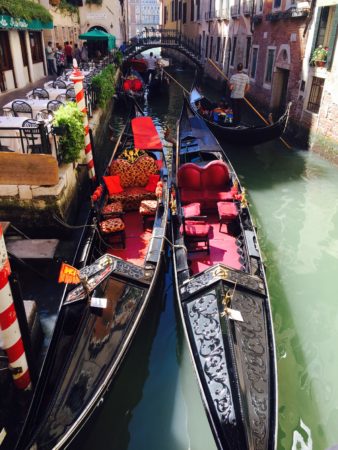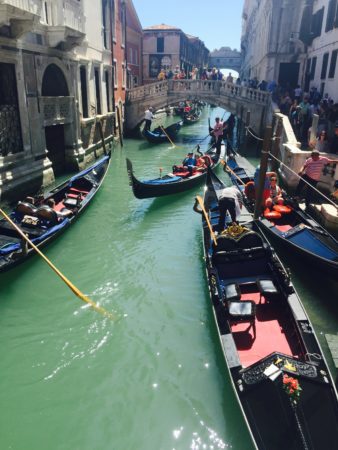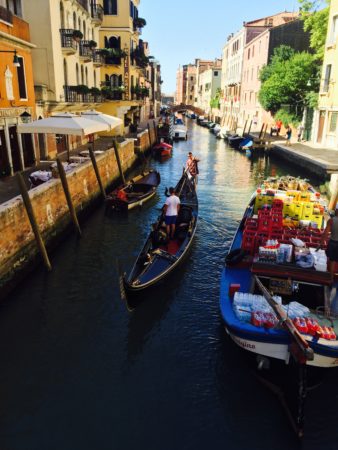Venice. How can one visit this mystical city without stepping into one of those sleek black Gondolas at least once? Quietly gliding beneath one or two of the 409 bridges that span the 150 plus channels, linking the 117 small islands that constitute Venice while enjoying the soothing baritone of your Gondolier’s narration. Admiring the softly decaying brick facades with petticoats of lush green moss while trailing fingers in the clear aqua marine waters as your Gondolier croons a sweet ballad. Sigh! While standing atop one of the bridges watching the many Gondolas gliding deftly beneath, I became a tad curious. Why are they all black? What does that pointy thing on the stern symbolize, and why are the Gondoliers male?
A spot of sleuthing later and here’s the low down:
Although always black (six coats) – the result of a 17th century law a doge enacted to eliminate competition between nobles for the fanciest machine – each Gondola has unique upholstery, trim and detailing but with just three flourishes – a curly tail, a pair of seahorses and a multi pronged prow. The six horizontal lines and curved top of the prow represent Venice’s six districts and the doge’s funny cap. Each one weighs 700g, has 280 components and uses eight types of wood. Interestingly they are slightly lopsided and bow out on the left, this asymmetry causing the Gondola to resist the tendency to turn toward the left at the forward stroke and compensates for the weight of the gondolier who stands in the stern and rows only on the right side.
Just as the Gondola is an iconic symbol of Venice, so too the Gondoliere, or the traditional oarsman, each one sporting a jaunty black and white striped shirt and straw boater. Whereas once a male dominated industry, in 2010, Venice finally appointed its first ever female gondolier Giorgia Boscolo. Go girl! Jostling amongst the chunky Vaporettos (water bus), sleek timber speed boats, produce movers, the odd cruise ship and 400 fellow Gondoliere is not for the faint of heart but the Gondoliers nail it. After all they’ve had extensive periods of training and apprenticeship, six months including 400 hours of instruction in using the distinctive single oar that is used to propel the gondola, to be exact, plus an exam which tests knowledge of Venetian history and landmarks, foreign language skills and the practicalities of manoeuvring the Gondola through narrow canals. Interestingly, when a Gondolier dies, the licence passes to his widow.
Now that you’ve popped a Gondola ride on your Venetian agenda, here’s a few things to consider before you blindly take that Gondolier’s hand and settle into his sleek machine. Some might offer narration or conversation and if this is important to you, it pays to conduct a little interview with your potential Gondolier to see how you relate and whether you can understand him, at the same time reviewing the map to discuss the route for some are crowded and chaotic; the duration of the trip and the price. The latter is usually fixed however there’s room to haggle when it’s quiet or in off season.
Oh! And despite depictions in the movies, not all gondoliers sing. If you are hankering for a serenade, ask first. If you’ve had the good fortune to hire a musician and are yearning for a spot of ‘O Sole Mio’ (which comes from Naples), well that’s like asking a Jazz singer to sing Waltzing Matilda. Instead try requesting ‘Un canto Veneziano? (sing a Venetian song?) – ‘Venezia La Luna e Tu?’ (a Venetian song), and you may just be rewarded. Enjoy!




